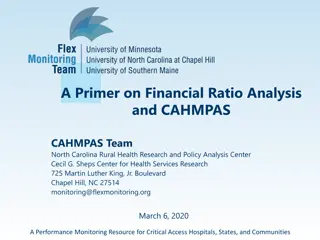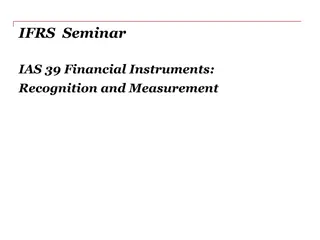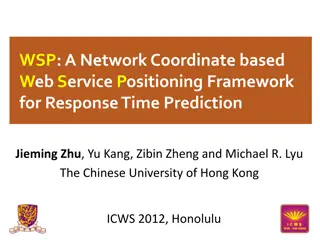Meet Financial Industry Experts at Today's Web Seminar
Danielle Fugazy, Charles Cardall, and John Wang are prominent professionals discussing the intricacies of the financial industry and municipal finance. Gain insights from their experiences in capital markets, municipal finance tax, and public finance. Learn about their backgrounds, expertise, and contributions to the field through articles, publications, and panel discussions. Connect with these industry leaders to enhance your understanding of financial topics and stay updated on the latest trends in the market.
Download Presentation

Please find below an Image/Link to download the presentation.
The content on the website is provided AS IS for your information and personal use only. It may not be sold, licensed, or shared on other websites without obtaining consent from the author.If you encounter any issues during the download, it is possible that the publisher has removed the file from their server.
You are allowed to download the files provided on this website for personal or commercial use, subject to the condition that they are used lawfully. All files are the property of their respective owners.
The content on the website is provided AS IS for your information and personal use only. It may not be sold, licensed, or shared on other websites without obtaining consent from the author.
E N D
Presentation Transcript
Welcome to Today's Web Seminar SPONSORED BY HOSTED BY
Danielle Fugazy is a journalist covering the financial industry. Her has included capital markets, private equity, M&A and bond industry. Since pursuing a freelance career in 2006, Danielle have written for numerous publications including Mergers & Acquisitions Magazine, American Banker, ACG s Middle Market Growth, Investors Dealers Digest, Private Equity Professional Digest, Venture Capital Journal, Dealmaker Magazine, Thomson Reuters and Portfolio.com. Additionally, Danielle has regularly moderates panel discussions and webinars as well as conducts video interviews. Prior to pursuing a freelance career, Danielle was the editor of Buyouts Magazine, which was a Thomson Reuters publication. Danielle began her financial journalism career with WebFinance, covering the online financial services beat. SPONSORED BY HOSTED BY
Charles Cardall, a partner in the San Francisco office, is the Chair of the Tax Department and is a member of the Public Finance Department. Chas primarily focuses his practice on municipal finance tax and nonprofit corporation tax matters. He also has legal expertise relating to both charter schools and the federal income tax classification of governmental and quasi-governmental entities. He has consulted on thousands of tax-exempt, build America and tax credit bond issues and has developed deep expertise in almost every tax aspect of municipal finance. Private activity bonds for multifamily housing, solid waste, charter schools and independent schools are areas of particular focus in his practice, as are higher education, short-term and long-term working capital and the various forms of pooled financings. Chas also has advised numerous clients experiencing financial distress or bankruptcy in tax matters relating to their municipal bonds. Representative active clients include the State of California, the University of California, the Bay Area Toll Authority, and Charter School Capital. T. 415-773-5449 E. ccardall@orrick.com Chas is a regular panelist at industry and bar association seminars on public finance tax topics (most recently on the topics of working capital financing and IRS enforcement) and has lectured to the IRS at their field agent training program. SPONSORED BY HOSTED BY
John Wang is a partner in the San Francisco office and a member of the Public Finance Department. John's practice includes serving as bond counsel, disclosure counsel, underwriter's counsel and borrower s counsel on a wide variety of transactions. John was recently recognized as one of California's top 50 development lawyers by The Daily Journal. John has significant experience with advising issuers, developers and underwriters on financings for higher education, utilities (including water, wastewater and energy facilities), solid waste disposal facilities (including waste-to-energy facilities) and 501(c)(3) corporations. He has experience advising clients in such financings in several states and territories, including California, Hawaii, Guam and Texas. T. 415-773-5993 E. jwang@orrick.com SPONSORED BY HOSTED BY
Roger L. Davis is Chair of Orricks Public Finance Department, which resides in nine offices around the country, and for most of the last two decades has ranked as number one bond counsel and disclosure counsel and within the top three underwriters counsel for state and local government bonds throughout the United States. Roger spends most of his time maintaining a substantial practice in public finance. He is lead counsel on an average of more than 30 transactions a year. While he continues to work on virtually every type of municipal security, in recent years, his focus has been on general governmental transactions, all manner of nonprofit corporations, public private partnerships (P3s) (including student housing), securitizations, energy related programs, pool programs and development of new products and programs. His practice is national but mostly in a number of western states, Hawaii and several Pacific islands. T. 415-773-5758 E. rogerdavis@orrick.com Roger also advises on securities laws and disclosure and drafts legislation (enacted in several states) to facilitate borrowing by public entities for a wide variety of projects and programs. SPONSORED BY HOSTED BY
California and New York MCLE Credit Available To qualify: Download the form from the recap email Complete the form, and enter code provided Follow the instructions on the form to return Orrick | February 25 6
Comparing Financing Structures for Student Housing Chas Cardall, John Wang, Roger Davis
Overview 1. UNIVERSITY BONDS: Project owned by university Project controlled by university 2. AUXILIARY BONDS: Project owned by related nonprofit Project indirectly controlled by university 3. THIRD-PARTY BONDS: Project owned by unrelated nonprofit Project influenced by university 4. GOVERNMENT OWNERSHIP BONDS: Project owned by unrelated government Project controlled by unrelated government Orrick | July 2016 8
Polling Question #1 I work for or primarily with public universities I work for or primarily with private universities I work with both public and private universities Orrick | July 2016 9
University Bonds Investors Conduit issuer required for private university $ Conduit Issuer Project owned by university Project development and management directly controlled by university University Developer and/or Manager University controls credit process, disclosure and investor outreach Revenues Proceeds University credit vs. project credit (on credit) Project Tax considerations with private manager and summer rentals Orrick | July 2016 10
Auxiliary Bonds Investors Conduit issuer required $ Bonds Auxiliary nonprofit controlled by university borrows proceeds and owns project Conduit Issuer University $ Loan Control of auxiliary nonprofit gives university indirect control of project Board Control Auxilliary Borrower University can control credit process, disclosure and investor outreach Developer and/or Manager Proceeds Revenues Project Project-based credit but on-credit for university Tax considerations for auxiliary and with private manager and summer rentals Orrick | February 25 11
Third Party Bonds Investors Conduit issuer required $ Bonds Unrelated nonprofit owns project and borrows proceeds Conduit Issuer Loose affiliation between nonprofit and university University $ Loan University obtains ownership when bonds are paid Many variations as to control of project development and management Unrelated Non profit University involved in credit process, disclosure and investor outreach Proceeds and Revenues Developer and Manager Project finance documentation and credit but on credit for university Project Tax considerations for unrelated nonprofit and with private manager and summer rentals Orrick | February 25 12
Important Features of Third-Party Bonds 1. Not a direct university financing, so debt capacity may be preserved for other purposes 2. On the other hand, depending on where housing facility is located (i.e., on campus or off) and other factors, might still be on credit to university and still be considered in evaluating rating on university s bonds 3. Potential Lack of Control Over a) Credit Process b) Disclosure c) Investor Outreach/Marketing d) Developer Selections 4. Headline risk in the event project goes bad is exacerbated where university actual financing or other involvement was minimal Orrick | February 25 13
Polling Question #2 Which consideration is most important to you? A. Credit or debt capacity impact on university B. Balance sheet impact on university C. Procurement or development efficiency issues D. Lowest cost of borrowing Orrick | February 25 14
FINANCING TRUST STRUCTURE (FTS): A Variation of the Third-Party Revenue Bond Theme Similar in Structure to general Third-Party Bonds, but employs a Financing Trust Agreement structure (FTS). Unique Features: 1. A structure that pools project security (revenues, real estate, etc.) from multiple projects, 2. Liquidity pooling account funded by each new series/project that secures all projects 3. Requires minimal rating standard across program, i.e., generally that no new project/series will lower ratings on any current bonds to below investment grade 4. Rate covenant based on aggregate net revenues and aggregate annual debt service Orrick | February 25 15
FTS Structure FinancingTrust Agreement University Affiliation Loan Indenture Owner/ Borrower Agreement Issuer Trustee Developer Contract Developer CashFlows Service Agreement UniversityProject A University Project B Operator Proj 4 Proj 1 Proj 2 Proj 3 Liquidity PoolingAccount Orrick | February 25 16
FTS A Better Third-Party Model? Preserves Debt Capacity: Alternative financing vehicle allows university to preserve debt capacity for other mission critical projects Maintains Control: Since FTS is university developed and maintained, Gives university control regarding: 1. Credit discussions, as projects may still be on credit even if off balance sheet 2. Disclosure discussion 3. Discussion relating to marketing of bonds, investor outreach, etc. 4. Allows university, not developers, to control/originate development of housing projects it wants to finance; could be decided at campus level or university central Orrick | February 25 17
FTS A Better Third-Party Model? (contd) Maintains Efficiency 1. The FTS program uses standard model documents, so it can be reproduced at scale 2. A structure that includes multiple projects, perhaps from multiple campuses, is able to achieve a lower cost of capital compared to a stand-alone project financing Maintains Optionality 1. Unlike the general Third-Party Bonds, this takes the financing responsibility away from the developer, but still allows the university to procure developers to design, build and operate the projects Orrick | February 25 18
Why Do We Need a Fourth Way? 1. Off Balance Sheet 2. Off Credit 3. No unrelated third party nonprofit corporation borrower 4. No affiliation agreement with university Orrick | February 25 19
Polling Question #3 Do you think there is an increasing trend to more private development of student housing? Orrick | February 25 20
Ownership Structure JPA doesn t lend bond proceeds to university, auxiliary or nonprofit, but uses the proceeds to buy or develop the project JPA Developer/Seller Bonds become governmental program bonds Project Purchase Agreement Indenture No involvement by university is required Revenues Trustee Manager Project Revenues New, first transaction was 2014 Bonds Financial Consultant Several conduits have done or approved concept of ownership structure Orrick | February 25 21
Advantages 1. JPA owns the project. No third party borrower. 2. Bonds are governmental purpose bonds not qualified 501(c)(3) bonds. Private activity bond rules do not apply (no TEFRA hearing and approval or 2% cap on costs of issuance). 3. JPA ownership may, under certain circumstances, convey property tax exemption. 4. Off balance sheet, off credit. 5. No university affiliation required beyond maybe including the project on the list of available student housing options. 6. University could still be the operator, but may interfere with off credit and maybe even off balance sheet (or footnote) accounting treatment Orrick | February 25 22
JPA/Developer 1. JPA is not liable on the bonds except from project revenues. Contracts out all of its operational responsibilities to an operator, asset manager, bond trustee, consultant, or combination. Owner s tort risk covered by insurance, indemnities and expense reserve. 2. Developer gives up ownership of the project, but can derive profit in a variety of ways: a. selling the project to the JPA, or if it is to be built, selling development rights or ground lease to JPA b. development fee c. operator/management fee (qualified management contract) d. asset management fee e. possible fees for pre-opening services or centralized services f. subordinate bonds with relatively high tax exempt interest Orrick | February 25 23
JPA/Developer 3. JPA owns the project and can keep it or give it away, subject to the bonds and mortgage if the bonds are outstanding. For example, gift to university. 4. Alternatively, developer can arrange to get the project back: a. option to purchase (greater of amount needed to defease bonds or then fair market value) b. ground lease (for period long enough to convey tax ownership to JPA), reversion to developer at end of term 5. Tax considerations Orrick | February 25 24























